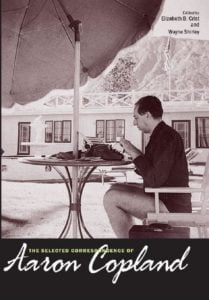-
- Aaron Copland – El Salón México Piano solo with sheet music (partitura)
- El Salón México
- The dance hall
- The music
- History of the work
- Sobre esta pieza
Aaron Copland – El Salón México Piano solo with sheet music (partitura)

El Salón México
El Salón México is a symphonic composition in one movement by Aaron Copland, which uses Mexican folk music extensively. Copland visited Mexico several times in the 1930s. The four melodies of the piece are based on sheet music he purchased during his visits.
The dance hall
The work is a musical depiction of a dance hall in Mexico City called “El Salón México”, which, as its name implies, represents the country of Mexico, with multiple types of music played. The subtitle was “A Popular Type Dance Hall in Mexico City.”
Copland observed that he despaired of the ability to portray, or even understand, the complexity that is Mexico. He continues to say that what he wrote, and what he knew he was writing, was a portrayal of the “visible” Mexico, to some extent the touristy Mexico. He chose dance as the vehicle for his musical portrayal.
Although Copland wrote in his autobiography that he had been taken to “El Salón México” by Carlos Chávez, he also learned of it from a guidebook:
Perhaps my piece might never have been written if it hadn’t been for the existence of the Salón México. I remember reading about it for the first time in a tourist guide book: “Harlem-type nightclub for the peepul [ sic in the original ], grand Cuban orchestra. Three halls: one for people dressed in your way, one for people dressed in overalls but shod, and one for the barefoot.” When I got there, I also found a sign on the wall which said: “Please don’t throw lighted cigarette butts on the floor so the ladies don’t burn their feet.”
…In some inexplicable way, while milling about in those crowded halls, one really felt a live contact with the Mexican people — the atomic sense one sometimes gets in far-off places, of suddenly knowing the essence of a people — their humanity, their separate shyness, their dignity and unique charm.

El Salón México, at Pensador Mexicano 16, opened in 1920 and was the dance capital of Mexico City. For dance bands it was the leading venue in the capital and country, where a wide variety of tunes were played: waltz, foxtrot, tango, pasodoble, and the Cuban danzón; Cuban orchestras often played there, and one Cuban orchestra that appeared regularly wrote a danzón called “Salón México”. It was a place to dance and, it was said, smelled of sweat.
Browse in the Library:
Or browse in the categories menus & download the Library Catalog PDF:
There was one entrance, but three doors off of it, where patrons sorted themselves by what kind of music and dances they wanted. It was a rare venue where rich, middle class, and poor all attended, with a famous sign, in the lower-class or “proletariat” room, where barefoot dancing was frequent, saying “Don’t throw cigarette butts on the floor because the ladies will burn their feet.”
The hall had murals, now lost, by Diego Rivera, Salvador Novo, Dolores Olmedo, and others. It closed in 1960.
The music
The work contains three musical styles and goes through the series of three twice, starting each time with the upper-class music, passing through a more vigorous working-class music, and ending with the foot-stomping dance of the peasantry.
Divisions between the sections are clear, as if one had walked through a doorway. The upper-class music suggests formal European dancing of the nineteenth century, unlyrical and even unmasculine. The peasant music is far richer rhythmically and more powerful, with a suggestion of the pre-Hispanic (Indian) in it. The work’s conclusion celebrates this kind of music, not that of the well-to-do. Musically, the work displays beautifully Copland’s populism.
History of the work
Copland began the work in 1932 and completed it in 1936. The Mexico Symphony Orchestra gave the first performance under the direction of Carlos Chávez in 1937. The piece was premiered in the U.S. in 1938.
Although Copland visited Mexico early in the 1930s, he based this tone poem not on songs he heard there, but rather on written sheet music for at least four Mexican folk songs that he had obtained: “El palo verde,” “La Jesusita,” “El mosco,” and “El malacate.” The powerful refrain that appears in the piece three times stems from “El palo verde.” Critics have variously described the piece as containing two, three, or four parts, but many listeners find that it moves seamlessly from one theme to another with no clear internal boundaries.
At least three arrangements of the piece exist in addition to the orchestral score. Copland adapted the work for the 1947 musical film Fiesta, directed by Richard Thorpe for MGM. Leonard Bernstein created arrangements for solo piano and for two pianos, four-hands very shortly after the premiere. In addition, a piano transcription of the score was made by conductor Arturo Toscanini in 1942, when the Maestro included the music on an NBC broadcast concert.
In 2006, Paul Glickman and Tamarind King started work on an animated short film based on the Aaron Copland score. In 2007 “El Salón México” received a New Mexico New Visions $20,000 work grant. In 2009 “El Salón México” debuted at The Film Museum Theater in Santa Fe, New Mexico. The computer-animated short was accepted into the following film festivals: Rome International Film Festival (2009 winner, Sylvia Award for Best Animation), Independent’s Film Festival (2009 winner, Best Independent Animation), Santa Fe Film Festival, Kids First Film Festival, Santa Barbara International Film Festival, and the Tiburon International Film Festival.
Sobre esta pieza
Aunque pensamos que Copland es particularmente “americano”, debería ser en el sentido geográfico y cultural más amplio. Viajó extensamente, de Canadá a Argentina, y escribió y dio conferencias con frecuencia sobre fuentes musicales que van desde el blues rural hasta el frevo brasileño.
El primer viaje de Copland a México fue en 1932, a instancias de su amigo Carlos Chávez, el compositor y director de orquesta entonces la figura dominante en la música artística mexicana, y director nacional de Bellas Artes. Muy impresionado con el pueblo, la música y el gobierno revolucionario, Copland regresó varias veces en largas vacaciones de trabajo.
El primer producto de ese viaje inicial a México fue la Sinfonía Corta. El final de la Sinfonía incorpora elementos tradicionales que Copland había escuchado en su viaje. Chávez dirigió el estreno en la Ciudad de México en 1934.
Aunque se terminó más tarde, El Salón México fue otro recuerdo de ese viaje, y una obra fundamental en el uso que Copland hizo de la música folclórica/popular. La obra registra las experiencias de Copland en un salón de baile popular del mismo nombre, con trozos de auténticas canciones mexicanas que Copland encontró en antologías publicadas, mezcladas en una espumosa mezcla orquestal.
Copland completó la orquestación en 1936, y Chávez dirigió el estreno en Ciudad de México en 1937. El Salón México se escuchó por primera vez en Estados Unidos en una emisión de radio, con Adrian Boult al frente de la Sinfónica de la NBC en 1938.
Copland no tenía ilusiones sobre la profundidad de esta traducción musical. “Todo lo que podía esperar era reflejar el México de los turistas, porque en ese punto caliente[El Salón México] se sentía, de una manera muy natural y no afectada, un contacto cercano con el pueblo mexicano. No fue la música lo que escuché, sino el espíritu que sentí allí lo que me atrajo y lo que espero haber puesto en mi música”.
“Copland ha sintetizado aquí lo más característico de la melodía popular mexicana sin quitarle frescura y belleza”, escribió el crítico Baqueiro Forster sobre el estreno. “Ha compuesto música que encarna nuestra canción folclórica en su forma más pura y perfecta.”
Aunque pensamos que Copland es particularmente “americano”, debería ser en el sentido geográfico y cultural más amplio. Viajó extensamente, de Canadá a Argentina, y escribió y dio conferencias con frecuencia sobre fuentes musicales que van desde el blues rural hasta el frevo brasileño.
El primer viaje de Copland a México fue en 1932, a instancias de su amigo Carlos Chávez, el compositor y director de orquesta entonces la figura dominante en la música artística mexicana, y director nacional de Bellas Artes. Muy impresionado con el pueblo, la música y el gobierno revolucionario, Copland regresó varias veces en largas vacaciones de trabajo.
El primer producto de ese viaje inicial a México fue la Sinfonía Corta. El final de la Sinfonía incorpora elementos tradicionales que Copland había escuchado en su viaje. Chávez dirigió el estreno en la Ciudad de México en 1934.
Aunque se terminó más tarde, El Salón México fue otro recuerdo de ese viaje, y una obra fundamental en el uso que Copland hizo de la música folclórica/popular. La obra registra las experiencias de Copland en un salón de baile popular del mismo nombre, con trozos de auténticas canciones mexicanas que Copland encontró en antologías publicadas, mezcladas en una espumosa mezcla orquestal.
Copland completó la orquestación en 1936, y Chávez dirigió el estreno en Ciudad de México en 1937. El Salón México se escuchó por primera vez en Estados Unidos en una emisión de radio, con Adrian Boult al frente de la Sinfónica de la NBC en 1938.
Copland no tenía ilusiones sobre la profundidad de esta traducción musical. “Todo lo que podía esperar era reflejar el México de los turistas, porque en ese punto caliente[El Salón México] se sentía, de una manera muy natural y no afectada, un contacto cercano con el pueblo mexicano. No fue la música lo que escuché, sino el espíritu que sentí allí lo que me atrajo y lo que espero haber puesto en mi música”.
“Copland ha sintetizado aquí lo más característico de la melodía popular mexicana sin quitarle frescura y belleza”, escribió el crítico Baqueiro Forster sobre el estreno. “Ha compuesto música que encarna nuestra canción folclórica en su forma más pura y perfecta.”
Browse in the Library:
Or browse in the categories menus & download the Library Catalog PDF:
